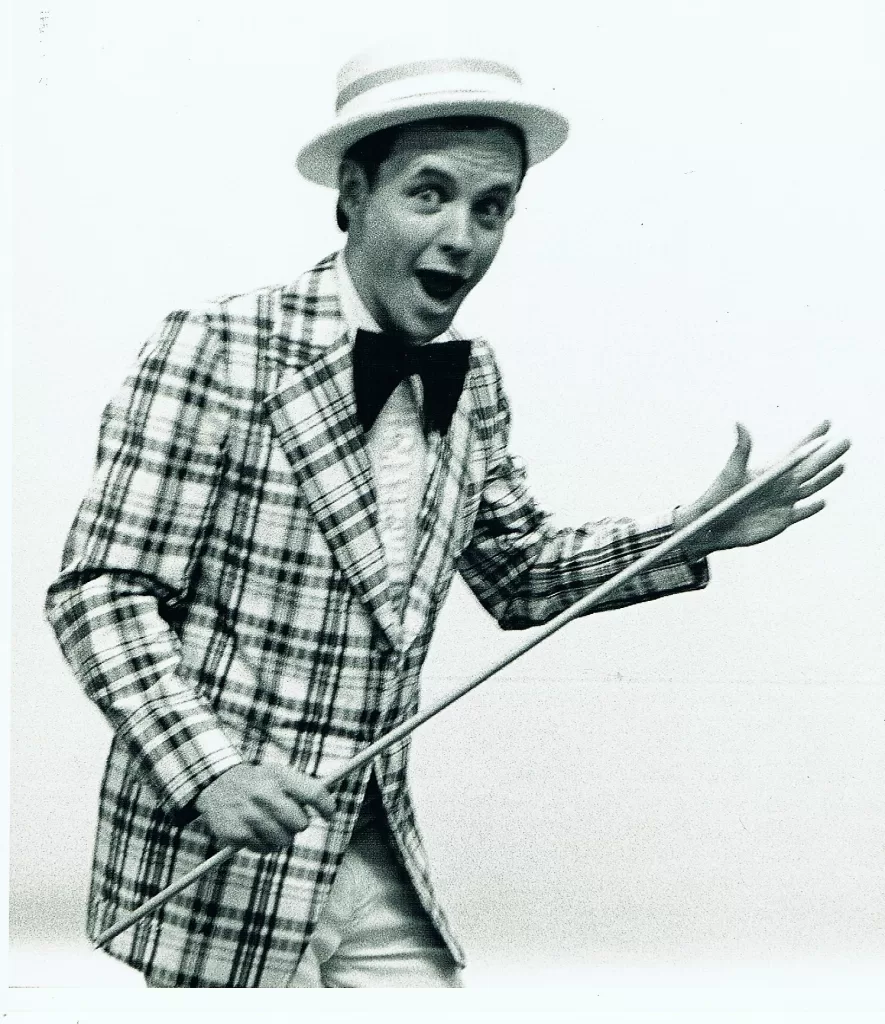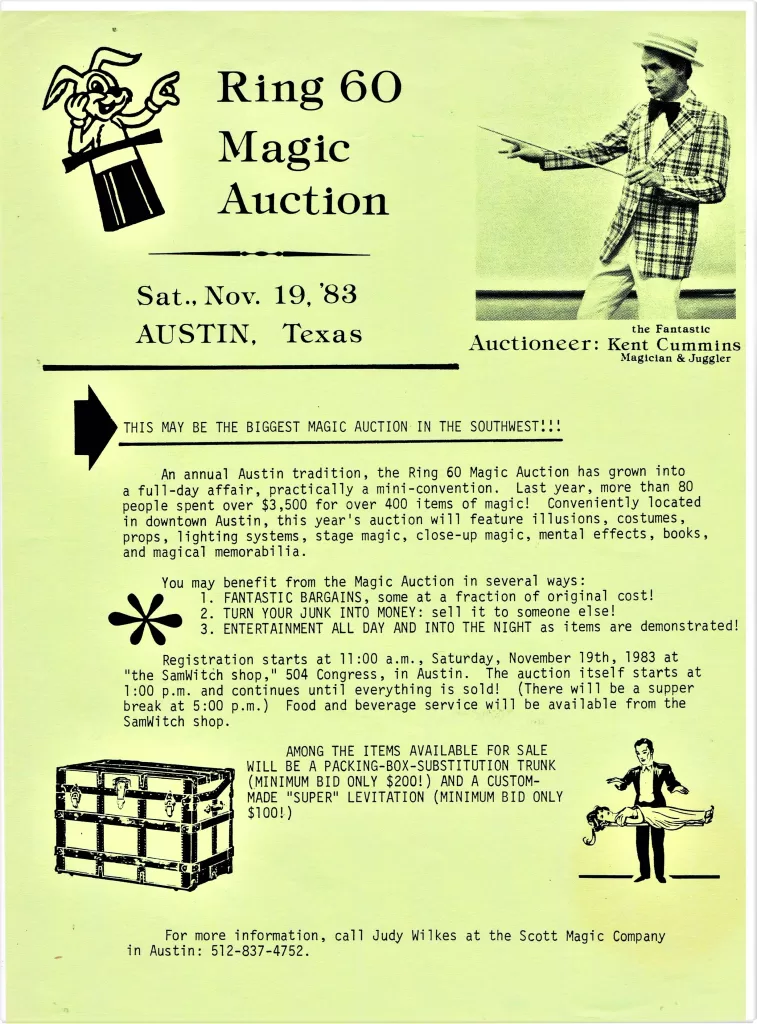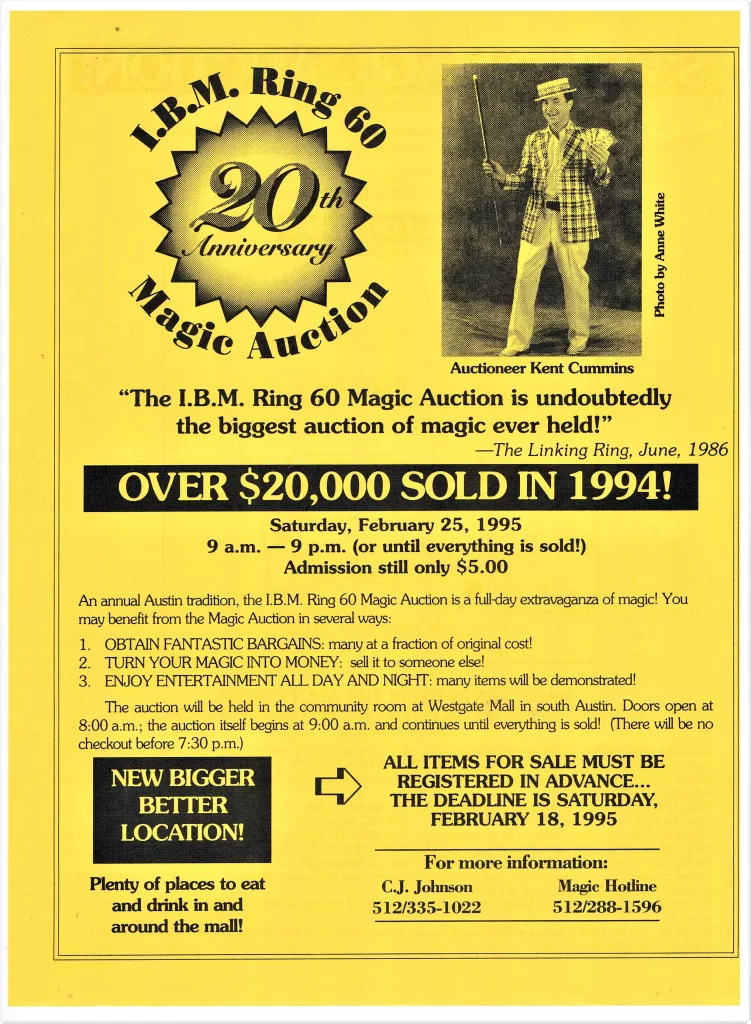…when and how it all began! (the first twenty-two years)
#1 – November 20, 1975
The very first “Austin Magic Auction” was held at the Dottie Jordan Recreation Center as a part of the very first “Mini-Convention,” a project by Austin IBM Ring 60 for their Junior Ring, which was very active during this time. John Novak brought some magic from Lou Berkie’s “Fun ‘n Magic Shop” in San Antonio where he worked, and auctioned it off to the participants. The Mini-Convention had one show, one lecture, and the auction was the “one magic dealer.”
The Ring 60 newsletter for December 1975 (Volume 1, No. 5) provided this history of the Junior Ring:
“Early in 1975 Gary Close, Director of the Jordan Recreation Center, called the Scott Magic Company to ask about some ‘tricks’ he could learn to teach a few boys who wanted to learn about magic. Scott had been thinking about ways to encourage young magicians so he volunteered to teach the course offered by the Austin Parks and Recreation Department at the Jordan Center. Ring 60 President Richard Van Slagle has shared the teaching duties with Scott. Since then, more than 60 youngsters have completed the six-week course. Many of them have remained interested and joined the Junior Ring that was formed around the first graduates of the class……The high point of the year was the First Annual Mini-Convention in November, attended by over 80 magicians and friends.”
#2 – November 19, 1976
“The Second Annual Junior Magicians Mini-Convention was an unqualified success,” according to the Ring 60 newsletter (Vol. 2, No. 11) edited by Judy Wilkes (later Donaldson, and then Hollingsworth). “Scott (Donaldson) put on his auctioneer’s hat and prodded bidders for almost an hour with some 35 pieces of magic going to new homes. The bargains were many and the selection varied. The auction was another of the high points of the day.” Attendance was 28 people, with adults paying $3.50 and juniors paying $2.00. The Ring made a profit of $36.00.
#3 – November 19, 1977
“The third Annual Mini-Convention was another great success. Lou Hornung was auctioneer, and a good job he did, too, selling all but two of the 43 items up for bid.” (IBM Ring 60 Newsletter Vol. 3, No. 11, November. 1977) The Ring made a profit of $43.85.
#4 – November 18, 1978
The fourth Mini-Convention retained the auction, as described in the Ring 60 newsletter: “Judy Wilkes handled the auction registration and Steve Farmer did a grand job of auctioning off the 51 items up for sale. $152.15 changed hands, with the Junior Ring realizing a profit of $18.41, including one auction item donated by Kent Cummins.” 34 people paid $1.00 to attend. It was Kent’s first Mini-Convention, and he noted that Steve had not been given the opportunity to study the items before offering them for sale. Kent asked Judy if he could volunteer to be the auctioneer the next year, and she cheerfully agreed.
#5 – November 10, 1979
More than fifty people paid $1.50 each to attend the fifth annual Mini-Convention. As planned, Kent Cummins became the auctioneer. He wore a seersucker jacket and plastic “straw hat” that he had worn for an Army presentation at Fort Lee, Virginia. Scott & Judy were able to get the auction items donated far enough in advance that Kent could review and devise a sales pitch for each item. He remembers repairing broken items, adding silks and other supplies, and photocopying catalog descriptions and instructions. The result was an increase in sales to more than $400!
#6 – November 22, 1980
The sixth annual Mini-Convention moved to the Northwest Recreation Center, with fifty people paying $1.50 each to attend. Kent continued as auctioneer, with sales of 82 items exceeding $500 ($545) and profit exceeding $100 ($108.33) for the first time. The auction ran from 4:00 to 5:30 pm.
#7 – November 15, 1981
The auction moved from the Recreation Center to the Austin Cabaret Theatre owned by Kent Cummins, in the Village Shopping Center in North Austin. For the first time, more than 100 items (214) were sold. A separate flyer was used to promote the auction as part of the Mini-Convention. Admission increased to $3.00, and the auction itself was held from 3:30 to 6:00 pm.
#8 – November 20, 1982
The auction moved to the SamWitch shop at 504 Congress, also owned by auctioneer Kent Cummins. The rest of the Mini-Convention was cancelled to provide more time for the auction, which attracted a record-setting 81 people. Registration started at 11:00 am; the auction was held from 1:00 to 11:00 pm. There were 421 items sold, producing a staggering sales figure of $3,593.50, and a profit to the Ring of $383.46. Admission was $1.00.
#9 – November 19, 1983
The Auction returned to the SamWitch shop, again starting at 1:00 pm. This was the first time the auction sold more than 500 (551) items! Sales were “only” $3,234.45, with a profit of $386.46. 71 people attended. Scott famously said that the size of the auction had reached its peak.
#10 – February 16, 1985
IBM Ring 60 skipped the winter of 1984 to change the auction date to February, when magicians had more free time. The location was also changed, to the First Unitarian Church in North Austin, where Kent and Margot Cummins were members. The result was the first time with more than 100 people (101) each paying $1.00 to participate. The auction became a full-day affair, with registration starting at 8:00 am and the auction running from 10:00 am until 11:00 pm. This was the first time to have a Silent Auction (in all previous auctions, everything was auctioned from the stage!), a new feature suggested by Jack Mistro. The entire Wan Soo Troupe act by Scott and Judy was auctioned off with other illusions. More than 500 items were sold for a total of $7,876.80 (Eat your heart out, Scott!) and a profit of $940.15.
#11 – February 22, 1986
Back at the Unitarian Church, 108 people paid an increased admission of $2.00 each to bid on 615 items (540 of which actually sold), producing sales of $5,600.90 and a profit of $385.71. Kent had sold the SamWitch shops and become a full-time magician, so the auction committee decided to actually pay him to be auctioneer…a short-lived concept, with so many other people volunteering so many hours! The auction ran for 12 hours. The first article published about the auction appeared in the Linking Ring in June, saying, “The I.B.M. Ring 60 Magic Auction is undoubtedly the biggest auction of magic ever held.”
#12 – February 28, 1987
The first auction ad ever was run in the Linking Ring magazine, and a four-page flyer (with a new auctioneer photo for Kent—with the same jacket–by Richard Slagle) was created to promote the event. Attendance grew to 183 people, despite the increase in admission to $3.00. The result was the first time sales reached $10,000 ($10,606.80) and nearly $1,000 ($938.29) in profit. Scott said that NOW we had reached the peak!
#13 – February 27, 1988
New advertising artwork was donated by Paul Osborne. Paul also sent three of his theme park illusions for sale. Scott & Judy helped create many large “table tent” display boards upon which to staple the ever growing number of silent auction items. 167 people paid $3.00 each to participate. Sales were $11,588.83 with a profit of $387.08. An attempt at computerized check-out was a disaster!
#14 – February 25, 1989
Admission was raised to $5.00, with attendance of 170. For the first time, more than 1,000 items (1,145) were sold for a total of more than $14,000 and a profit of $1600.00. Mary Cay Patterson became the Auction Chairperson, while Kent remained the main auctioneer. Judy Donaldson created and conducted 3 “speed auctions.”
#15 – February 24, 1990
In addition to the regular auction, Ring 60 conducted a liquidation of the Clown Factory from a San Antonio mall, resulting in total auction sales of $26,237.50. More than 1,000 volunteer hours were expended by members of Ring 60 in order to inventory, transport, organize, price, and display the tricks, gags, and costumes for sale in the auction. The mall received nearly $15,000 for the merchandise, far more than they would have otherwise obtained. We took credit cards for the first time. Scott stopped making predictions!
#16 – February 23, 1991
205 participants paid $5.00 each to attend the 16th Ring 60 Magic Auction. One of the fifty or so volunteers was S.A.M. National President Margaret Dailey, from Indianapolis! Sales were $14,108.10.
#17 – February 29, 1992
254 participants using 189 bidder numbers purchased 2,094 items for total sales of $20,865.00. Guest auctioneers have included C.J. Johnson, Ray Anderson, T. Myers, Bobby Cordell, and Peter the Adequate, among others. “The kitchen made over $400 with all the delicious (sic) treats that were available during the day.” (Ring 60 Newsletter Volume 18, No. 3, March 1992)
#18 – February 27, 1993
“Ring 60’s famous MAGIC AUCTION broke all records again with over $21,000 of magic sold. Over 2,400 wonderful magic treasures were offered during the stage and silent auction. We had 66 sellers and 194 buyer numbers representing the 256 people who attended.” (Ring 60 Newsletter, Volume 19, No. 3, March 1993) Ron Cartlidge became an auction tagging party volunteer on the advice of Derek Kennedy from Fort Worth. (Kent’s “Magic Camp” started in the summer of 1993.)
#19 – February 26, 1994
The auction remained at the Unitarian Church. Anne White created a new auctioneer photo (with the same jacket) for Kent. 239 people paid $5.00 to participate; there were 2,357 items sold for a total of $23,185. And we didn’t take credit cards that year! (We also didn’t allow alcoholic beverages.)
#20 – February 25, 1995
The 20th Anniversary of the World Famous Austin Magic Auction was held in a large space that had formerly been a Children’s Museum Haunted House at Westgate Mall in South Austin. There were 74 sellers, 249 bidders, and 332 registrants. Sales included 3,378 lots which sold for more than $34,000, and $1,571.00 from a “Celebrity Auction” was personally accepted by Margaret Dailey for the scholarship fund of the Society of Young Magicians. (Yes, although IBM Ring 60 sponsored the auction, the money was donated to the S.A.M. youth group!) The Celebrity Auction received donations from David Copperfield, Walter “Zaney” Blaney, Mark Wilson, Michael Ammar, David Goodsell, Stan Allen, Bob Markwood, Anne White, and several other well-known magicians. One of the many interesting items offered for sale was a set of the foam rubber truck tires that ran over Teller in Penn & Teller’s 1990 television special. (The set went for $200.) The estate of Frank “Kovar” Mann was also liquidated at this year’s auction. The 20th anniversary auction was written up by Scott Wells, and featured with a three-page article in Magic magazine for April, 1995.
#21 – February 24, 1996
The auction returned to Westgate Mall, adding the huge space formerly occupied by Service Merchandise…making this year the biggest space ever used by the Austin Magic Auction! “For the second year, we will once again have a special Silent Auction area whose proceeds go to the Society of Young Magicians Scholarship Fund. Wonders of magical items and memorabilia from the magical and talented will be donated by the Magic Camps in Austin, Virginia, Denver, Illinois and the West Coast Wizards Camp.” (Ring 60 Newsletter, Volume 23, No. 2, February 1996.)
#22 – February 22, 1997
The 1997 auction was dedicated to Louis Berkie, proprietor of the ELBEE Company and Fun’n Magic Shop in San Antonio for nearly fifty years…appropriate, since the very first auction consisted of items from his shop! Held once again in Westgate Mall, this became the last of the IBM Ring 60 Magic Auctions. The following year, with Ring 60’s approval, the auction was taken over by the Fort Worth Magic Club. It was renamed the “Lone Star Magic Auction.”





